- 4 Aktuální žádosti o pomoc Poraďte svým kolegům
- Požádejte o pomoc
- Podejte dotaz do fóra
- Vložit hotový případ
- LOG Decoder
Žádost o pomoc
Žádost o pomoc vyplňte, pokud máte rozpracovaný diagnostický případ na konkrétním vozidle, u kterého potřebujete pomoci zjistit skutečnou příčinu závady.
Pro naše nekonvenční metody je nutný základ znalostí a mít vlastní vybavení minimálně pro "logování", lépe však osciloskop. Nejlepší přípravou pro práci jsou naše videoškolení a akademie.
Jak to funguje?
Do online formuláře v jednotlivých krocích vyplníte všechny důležité údaje k případu a poté Vám ostatní registrovaní diagnostici poradí v komentářích*.
Supervizor a moderátoři FCD.eu samozřejmě vše doplňují a kontrolují správnost informací, aby cesta vedla ke správnému cíli.
Požádat o pomocDiagnostický případ
FCD Logger – Remote diagnostics

Informace o vozidle
| VIN: | TMBEK6NW7L3037310 |
| Výrobce: | Skoda |
| Model: | Scala |
| Rok výroby: | 2019 |
| Kód motoru: | 1,5 TSi |
| Typ motoru: | DPCA |
| Výkon (kW): | 110 kW |
| Převodovka: | Manuální |
| Palivo: | Benzín |
| Najeto: | 10 km |
Jak se závada projevuje
Zvuky / vibrace. The engine is erratic following a cold start
Jak často se závada projevuje
-
Sporadicky / za specifických podmínek.
- Za studena.
V jakém systému se závada vyskytuje
- Motoru.
- neukládá žádný chybový kód
Doposud provedeno bez úspěchu
Vehicle inspection during purchase. No fault was revealed.Závěr
VOZIDLO JSEM NEOPRAVOVAL, PROVÁDĚL JSEM DIAGNOSTICKÉ PRÁCERemote diagnostics with the FCD Logger
The remote analysis identified a problem with the alternator drawing too much current. The rough running of the engine and jerking result from a high load on the alternator. This powertrain is well known for this accompanying phenomenon of "unstable running and jerking after a cold start". The jerking is expected to occur when the engine is warming up below 70°C. To resolve the problem, service technicians are advised to recharge the battery, turn off all electrical devices and then update the engine control unit software. However, even this procedure usually doesn't fix this issue, as reported by some owners after the engine ECU software update. The jerking isn't that evident, but the engine isn't running completely smooth. FCD Garage note: The mode where the engine is in the "catalyst heating phase" is generally "not smooth" and cannot be considered a "fault" in the true sense of the word. It's a feature that aims to warm up the catalytic converter to operating temperature as soon as possible so that the car doesn't pollute the environment. This is achieved. The manufacturer shouldn't program the maximum charging current at this stage. There is enough time to recharge the battery even after 30 seconds of this phase. Hopefully, all car manufacturer programmers (and others making the same mistakes) should remember this. Unfortunately, any change to the SW results in new homologation approval, which costs money. So, cosmetic engine hesitation after every cold start is included in the purchase price of this model.
Obrázky, fotografie a soubory
Maximum alternator charging restricting the sensitive mode (16238/1)
Immediately after a cold start, the alternator charges at maximum capacity, which is often just a software design programming error.The catalytic converter heat-up phase is working OK (16238/2)
After a cold start, the catalytic converter heats up correctly and intensely = OK (within approx. 30 s)Turbocharger bypass (16238/3)
During the "warm-up phase", the Wastegate is programmed to stay open, and the engine doesn't have the power like after warm-up.Engine passive resistances (16238/4)
Engine passive resistances are calculated from load and other parameters. Here they are in the standard expected range of around 10 %.Ignition point strategy (16238/5)
Negative ignition advance values are effective and functional. The deviation towards positive values just replicates the error of the large alternator draw.Rail fuel pressure (16238/6)
The fuel pressure is well within the expected values. The drop in pressure regulation is just a logical and inevitable consequence of the rpm drop due to the massive increase in max alternator draw.Throttle valve position after cold start (16238/7)
The throttle movement is just a reaction to the engine cutout to save the engine rpm. It's just a consequence, otherwise the throttle is OK. It's all just due to the massive and rapid surge of the alternator charging current.Wideband Lambda sensor (16238/8)
The spike is just a result of the engine stumbling due to the alternator, otherwise, the fuel-air ratio is OK after start-up.Absolute calculated load (16238/9)
The engine load is immense, and that's only because of the alternator. Here you can also see the unwanted stumbling of the engine.Engine temperature (16238/10)
The engine heat-up is normal.Oxygen shocks on the Lambda sensor signal (16238/11)
The evidence of the engine's inability to cope with the negative ignition advance values in the catalyst warm-up phase leads to misfires and erratic engine operation.Exhaust gas flow resistance is OK (16238/12)
There is nothing preventing the exhaust gas from escaping through the exhaust system. The values are in the millibar range. OK.Intake manifold pressure (16238/13)
The pressure in the intake manifold just replicates the massive alternator draw problems. Otherwise, the log values are within the normal range.Unstable air-fuel adaptives (16238/14)
Due to the erratic behaviour of the engine as a result of the alternator load, oxygen is present in the exhaust during misfires, causing high positive mixture adaptive values. Once the engine runs smoothly, these adaptives quickly return to negative values. This is just the result of a software error in the alternator recharging algorithms.Diagnostics were carried out remotely by the FCD Logger (16238/16)
Soubory ke stažení
-
xlsxRemote LOG recording (16238/15).xlsx Excel with graphics for custom evaluation. In the later stages of the test drive, the engine behaves normally in all parameters.Stáhnout soubor






















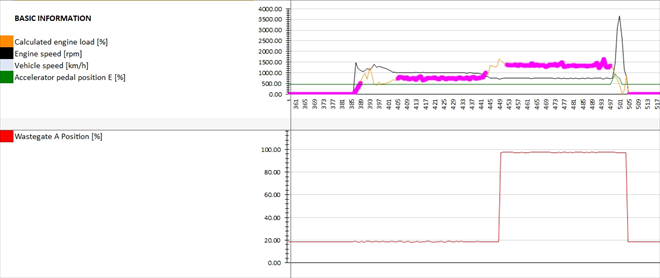
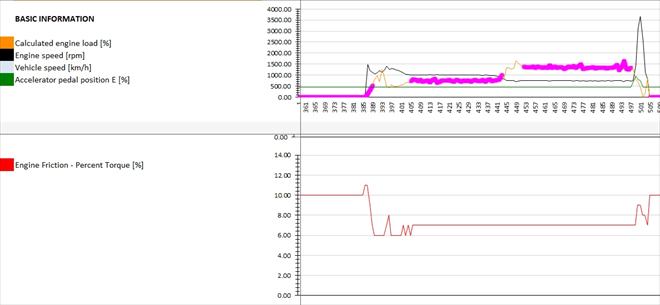
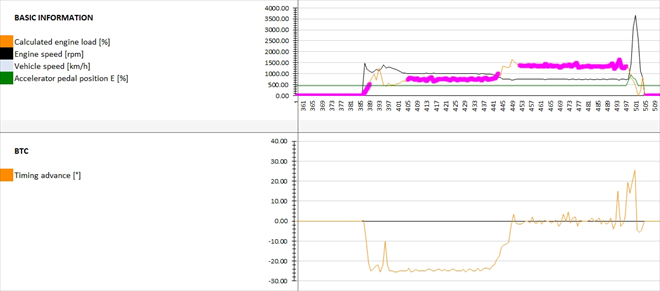
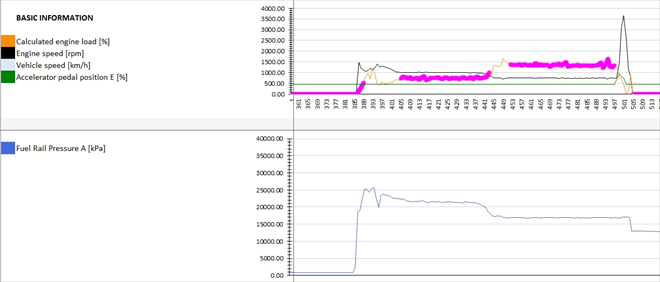




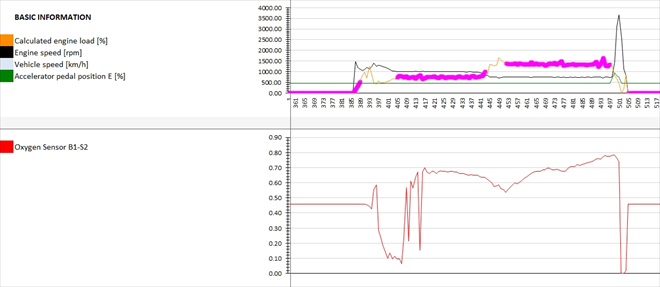
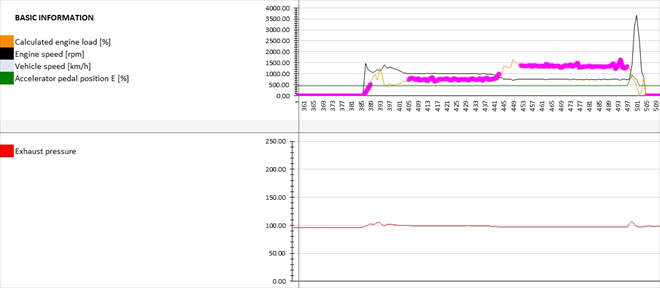
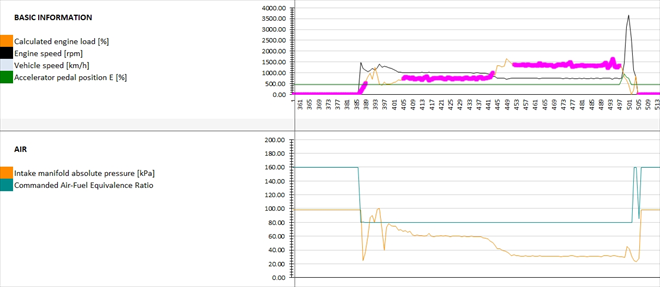


Komentáře (0)